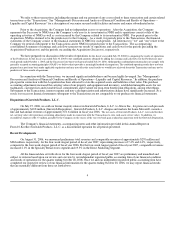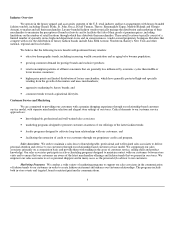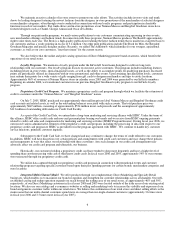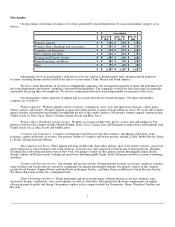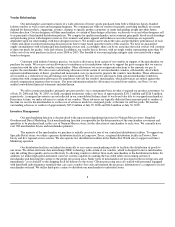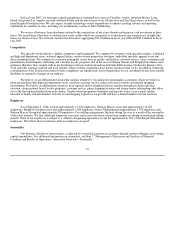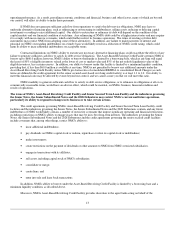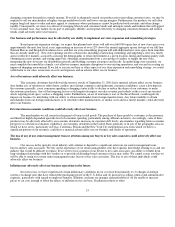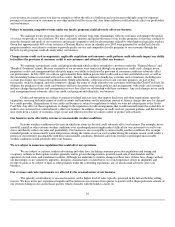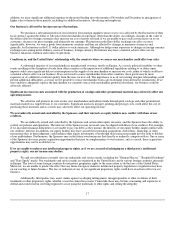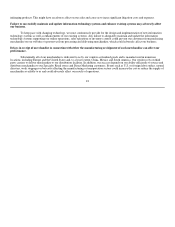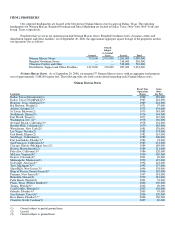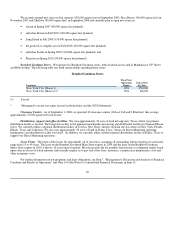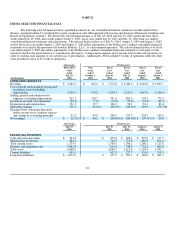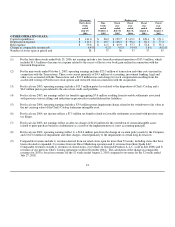Neiman Marcus 2005 Annual Report Download - page 17
Download and view the complete annual report
Please find page 17 of the 2005 Neiman Marcus annual report below. You can navigate through the pages in the report by either clicking on the pages listed below, or by using the keyword search tool below to find specific information within the annual report.
lenders to impose additional availability and other reserves, which could materially impair the amount of borrowings that would
otherwise be available to us. There can be no assurance that the agent bank will not impose such reserves or, were it to do so, that the
resulting impact of this action would not materially and adversely impair NMG's liquidity.
A breach of any of the restrictive covenants would result in a default under the Asset-Based Revolving Credit Facility and
Senior Secured Term Loan Facility. If any such default occurs, the lenders under the Asset-Based Revolving Credit Facility and Senior
Secured Term Loan Facility may elect to declare all outstanding borrowings under such facilities, together with accrued interest and other
fees, to be immediately due and payable, or enforce their security interest, any of which would result in an event of default under NMG's
Senior Notes and Senior Subordinated Notes and 2028 Debentures. The lenders would also have the right in these circumstances to
terminate any commitments they have to provide further borrowings.
The operating and financial restrictions and covenants in these debt agreements and any future financing agreements may
adversely affect NMG's ability to finance future operations or capital needs or to engage in other business activities.
Risks Related to Our Business and Industry
The specialty retail industry is highly competitive.
The specialty retail industry is highly competitive and fragmented. Competition is strong both to attract and sell to customers
and to establish relationships with, and obtain merchandise from, key vendors.
We compete for customers with specialty retailers, traditional and high-end department stores, national apparel chains, vendor-
owned proprietary boutiques, individual specialty apparel stores and direct marketing firms. We compete for customers principally on the
basis of quality and fashion, customer service, value, assortment and presentation of merchandise, marketing and customer loyalty
programs and, in the case of Neiman Marcus and Bergdorf Goodman, store ambiance. In our Specialty Retail business, merchandise
assortment is a critical competitive factor, and retail stores compete for exclusive, preferred and limited distribution arrangements with
key designers. Many of our competitors are larger than we are and have greater financial resources than we do. In addition, certain
designers from whom we source merchandise have established competing free-standing retail stores in the same vicinity as our stores. If
we fail to successfully compete for customers or merchandise, our business will suffer.
We are dependent on our relationships with certain designers, vendors and other sources of merchandise.
Our relationships with established and emerging designers are a key factor in our position as a retailer of high-fashion
merchandise, and a substantial portion of our revenues is attributable to our sales of designer merchandise. Many of our key vendors limit
the number of retail channels they use to sell their merchandise and competition among luxury retailers to obtain and sell these goods is
intense. Our relationships with our designers have been a significant contributor to our past success. We have no guaranteed supply
arrangements with our principal merchandising sources. Accordingly, there can be no assurance that such sources will continue to meet
our quality, style and volume requirements. Moreover, nearly all of the brands of our top designers are sold by competing retailers, and
many of our top designers also have their own dedicated retail stores. If one or more of our top designers were to cease providing us with
adequate supplies of merchandise or, conversely, were to increase sales of merchandise through its own stores or to the stores of our
competitors, our business could be adversely affected. In addition, any decline in the popularity or quality of any of our designer brands
could adversely affect our business.
If we significantly overestimate our sales, our profitability may be adversely affected.
We make decisions regarding the purchase of our merchandise well in advance of the season in which it will be sold. For
example, women's apparel, men's apparel and shoes are typically ordered six to nine months in advance of the products being offered for
sale while handbags, jewelry and other categories are typically ordered three to six months in advance. If our sales during any season,
particularly a peak season, are significantly lower than we expect for any reason, we may not be able to adjust our expenditures for
inventory and other expenses in a timely fashion and may be left with a substantial amount of unsold inventory. If that occurs, we may be
forced to rely on markdowns or promotional sales to dispose of excess inventory. This could have an adverse effect on our margins and
operating income. At the same time, if we fail to purchase a sufficient quantity of merchandise, we may not have an adequate supply of
products to meet consumer demand. This may cause us to lose sales or harm our customer relationships.
Our failure to identify changes in consumer preferences or fashion trends may adversely affect our performance.
Our success depends in large part on our ability to identify fashion trends as well as to anticipate, gauge and react to
14


